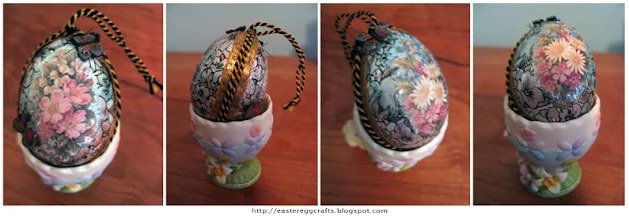Decoupage (or découpage) is the art of decorating an object by gluing colored paper cutouts onto it in combination with special paint effects, gold leaf
and so on. Commonly an object like a small box or an item of furniture
is covered by cutouts from magazines or from purpose-manufactured
papers. Each layer is sealed with varnishes (often multiple coats) until the "stuck on" appearance disappears and the result looks like painting or inlay
work. The traditional technique used 30–40 layers of varnish which were
then sanded to a polished finish. This was known in 18th century England as the art of Japanning after its presumed origins.
 |
| I decoupaged this hollow egg many years ago. I used a variety of papers both with both metallic and matte surfaces. The butterflies are made of Filmo clay. Read more about how to decoupage a larger picture from either a napkin or paper onto an egg's surface. |
The most likely origin of decoupage is thought to be East Siberian
tomb art. Nomadic tribes would use cut out felts to decorate the tombs
of their deceased. From Siberia, the practice came to China, and by the
12th century, cut out paper was being used to decorate lanterns,
windows, boxes and other objects. In the 17th century, Italy, especially
in Venice, was at the forefront of trade with the Far East and it is
generally thought that it is through these trade links that the cut out
paper decorations made their way into Europe.
Artisans in Florence, Italy
have produced decorative objects using decoupage techniques since the
18th century. They combined decoupage with other decorative techniques
already popular in Florence, such as gilt with gold leaf and carved wood designs. These older techniques were already used to produce articles such as furniture, frames for paintings, and even tooled leather book covers. Known as Florentine style crafts, these items are now highly collectible antiques.
Decoupage was added to the Florentine artisans' methods by adding it to
the space within a carved gilt frame, or by adding the decoupage to a
wooden plaque. Artisans used pasted reproductions of famous artworks,
nearly always religious depictions. Florentine triptychs using decoupage images of such Biblical scenes as the Crucifixion are a common motif. As society became more secular in the early 20th century, and non–Roman Catholic
tourists began buying more crafts from Florentine artisans, decoupage
images became less religious in orientation and more reflective of famous Italian artworks in general.
Common household materials can be used to create effects. Here is a short list of supplies:
- Something to decoupage onto. Examples include: furniture, photograph albums, plates, ceramics, shelving, frames, mirrors.
- Pictures to decoupage with. These can come from myriad sources: newspapers, magazines, catalogs, books, printed clip art, wrapping paper, greeting cards, fabric, tissue paper, lace, paper napkins
- Cutting utensil. Scissors, craft knife (X-Acto) or razor blades can be used.
- Glue. Standard white glue works best if it is diluted with a little water. Specialty glues can be found in most crafting stores.
- Smoother. Popsicle sticks work well. A brayer is a specialized tool like a miniature rolling pin designed to help remove wrinkles, remove excess glue and smooth pictures.
- Glue spreader. Many things around the house can be use for this: cotton swabs, paint brushes, sponges.
- Rags, sponges, tissue paper to help wipe up glue and other clean up.
- Sealer. Glue or other decoupage medium can be used as a sealer. Alternatively, polyurethane, spray acrylic, epoxy resin or other lacquers are usually used.
Mrs. Mary Delaney
achieved unexpected fame at the age of 71 in the court of George III
and Queen Charlotte of England thanks to the 18th century decoupage
craze. Moving in the circle of Jonathan Swift and Sir Joseph Banks, and
possibly taught art by William Hogarth, she was introduced to George III
and Queen Charlotte by Margaret Bentinck, Duchess of Portland, and
became a court favorite.
In 1771, she began to create cut out paper artworks (decoupage) as
was the fashion for ladies of the court. Her works were exceptionally
detailed and botanically accurate depictions of plants. She used tissue
paper and hand colouration to produce these pieces. She created 1,700 of
these works, calling them her "Paper Mosaiks [sic]", from the age of 71
to 88 when her eyesight failed her. They can still be seen in the
Enlightenment Gallery at the British Museum today.
Notable modern day "Master Decoupeurs" include Durwin Rice, Violet
Knoxville (Vanesa de la Puente) and Queen Margrethe of Denmark. Modern
day decoupage has evolved over the years beyond the simpler style of
gluing images to plates and vases. The use of high-tech printers,
resins, and enamel sprays contribute to the "modern" decoupage method.
How Emilie Lefler decoupages her eggs.
11 More Examples of Decoupage On Eggs:
- Egg Die-ing...Papertrey Style!
- How To Make Paper-Napkin Decoupage Easter Eggs (These are China Blue)
- Decoupaged and Glittered Eggs Egg Art and a DIY How To Tutorial - glitter versions
- Decoupaged Eggs with Vintage Botanical Prints
- Napkin Decoupaged Eggs with Old Things New
- Old-fashioned decoupaged eggs
- Fun with Decoupage Easter Eggs
- Paper Mojo Giveaway
- Easter eggs! Crafts! Pretty things! Spring!
- Decorating Easter Eggs with Decoupage from The Crafty Bee
- Decoupage Easter Eggs - Super Easy Copycat Pysanky

No comments:
Post a Comment
Thanks for your thoughts. All comments are moderated. Spam is not published. Have a good day!